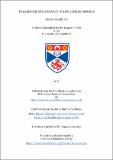Files in this item
Parameter redundancy in log-linear models
Item metadata
| dc.contributor.advisor | Papathomas, Michail | |
| dc.contributor.advisor | King, Ruth | |
| dc.contributor.author | Sharifi Far, Serveh | |
| dc.coverage.spatial | vii, 146 p. | en_US |
| dc.date.accessioned | 2017-09-25T14:31:41Z | |
| dc.date.available | 2017-09-25T14:31:41Z | |
| dc.date.issued | 2017-12-07 | |
| dc.identifier.uri | https://hdl.handle.net/10023/11739 | |
| dc.description.abstract | Log-linear models are widely used to analyse categorical variables arranged in a contingency table. Sampling zero entries in the table can cause the problem of large standard errors for some model parameter estimates. This thesis focuses on the reason of this problem and suggests a solution by utilising the parameter redundancy approach. This approach detects whether a model is non-identifiable and parameter redundant, and specifies a smaller set of parameters or combinations of them that all are estimable. The parameter redundancy method is adapted here for Poisson log-linear models which are parameter redundant because of the number and pattern of the zero observations in the contingency table. Furthermore, it is shown that in some parameter redundant log-linear models, the presence of constraints referred to as esoteric constraints can make more parameters estimable. It is proven in a theorem that for a saturated Poisson log-linear model fitted to an lm table with one zero cell count, which model parameters are not estimable. Three examples of real data in sparse contingency tables are presented to demonstrate the process of identifying the estimable parameters and reducing the model. An alternative approach is the existence of the MLE method that checks for the existence of the maximum likelihood estimates of the cell means in the log-linear model after observing the zero entries. The method considers the log-linear model as a polyhedral cone and provides conditions to detect the estimability of the cell means. This method is compared here with the parameter redundancy approach and their similarities and differences are explained and illustrated using examples. In parameter redundant models with existent MLE, it is observed that the presence of the esoteric constraints makes all the parameters estimable. | en |
| dc.language.iso | en | en_US |
| dc.publisher | University of St Andrews | |
| dc.rights | Attribution-NonCommercial-NoDerivatives 4.0 International | * |
| dc.rights.uri | http://creativecommons.org/licenses/by-nc-nd/4.0/ | * |
| dc.title | Parameter redundancy in log-linear models | en_US |
| dc.type | Thesis | en_US |
| dc.contributor.sponsor | Engineering and Physical Sciences Research Council (EPSRC) | en_US |
| dc.contributor.sponsor | University of St Andrews | en_US |
| dc.type.qualificationlevel | Doctoral | en_US |
| dc.type.qualificationname | PhD Doctor of Philosophy | en_US |
| dc.publisher.institution | The University of St Andrews | en_US |
| dc.identifier.doi | https://doi.org/10.17630/10023-11739 |
The following licence files are associated with this item:
This item appears in the following Collection(s)
Except where otherwise noted within the work, this item's licence for re-use is described as Attribution-NonCommercial-NoDerivatives 4.0 International
Items in the St Andrews Research Repository are protected by copyright, with all rights reserved, unless otherwise indicated.


